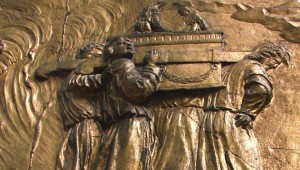Nephite Temple Worship Compared to Israelite Texts
The following is a portion of an article by Don Bradley entitled “Piercing the Veil: Temple Worship in the Lost 116 Pages.” This was a presentation given at the FairMormon Conference in 2012. Don’s position is that the Nephites worked to replicate the function of the temple from their old world in Jerusalem, to model their worship after this in such a way as to produce an equivalent structure, one that we can also see in the text of both the Book of Mormon and the Old Testament texts that come to us. I hope you enjoy the conclusions of Mr. Bradley and that they augment your study of the Book of Mormon as an ancient text.
And I, Nephi, did abuild a btemple; and I did construct it after the manner of the temple of cSolomon save it were not built of so many dprecious things; for they were not to be found upon the land, wherefore, it could not be built like unto Solomon’s etemple. But the manner of the construction was like unto the temple of fSolomon; and the workmanship thereof was exceedingly fine. (2 Nephi 5:16)
We go from the “who” now to the “how” of Nephite temple worship. Nephi wrote that he had built a temple like that of Solomon. This statement has drawn guffaws from critics, who note the enormous scale and grandeur of Solomon’s temple. But it isn’t the scale and grandeur of Solomon’s temple that made it a model for Nephi’s. Nephi wanted his temple to be like Solomon’s, not in size, but in functionality. To perform the rituals prescribed by the Law of Moses his people would need a temple parallel to Solomon’s in rooms and relics.
The modeling of Nephite worship on early Israelite worship in Jerusalem has been explored by Kevin Christensen. Christensen describes key features of Jerusalem worship from the days of Lehi’s youth, before the heavy-handed Josian reform, and then observes that Nephite religion contained all of these, “with the understandable exception of the specific temple artifacts kept in the holy of holies, the ark of the covenant…and the cherubim.”
 But while the Nephites’ omission of the Ark of the Covenant from their temple is, as he says, understandable, it is also glaring. The Jerusalem temple was, in one sense, a house for the Ark of the Covenant. The temple was structured in layers of sacredness, or degrees of glory, if you will, around the Ark, with the chamber that contained the Ark being the holiest place of all, the Holy of Holies. The Ark, bearing as it did the stone tablets God touched with His finger on Sinai during the Exodus, provided Israel an embodiment of His presence. The Ark also served as an altar, upon which the Aaronite high priest was required to sprinkle sacrificial blood during the all-important Day of Atonement.
But while the Nephites’ omission of the Ark of the Covenant from their temple is, as he says, understandable, it is also glaring. The Jerusalem temple was, in one sense, a house for the Ark of the Covenant. The temple was structured in layers of sacredness, or degrees of glory, if you will, around the Ark, with the chamber that contained the Ark being the holiest place of all, the Holy of Holies. The Ark, bearing as it did the stone tablets God touched with His finger on Sinai during the Exodus, provided Israel an embodiment of His presence. The Ark also served as an altar, upon which the Aaronite high priest was required to sprinkle sacrificial blood during the all-important Day of Atonement.
How could the Nephites keep the Law of Moses without access to the Ark of the Covenant? And with what, if not the miraculous relics of the Exodus, including their literal touchstones with Deity, would sufficiently sanctify their Holy of Holies to make it an appropriate dwelling place for God? As in the case of replacing the Aaronite high priest, they would have to introduce their own fitting substitute. Whether the Nephite temple was like Solomon’s on its exterior was irrelevant. Whether it was like Solomon’s here, at its heart, the Holy of Holies, was vital. Something, presumably something remarkable, would have to sit in the Ark’s place.
But what did the Nephites have that could stand in for the sacred relics of the Exodus kept in Solomon’s temple? They had their own sacred relics, including those of their exodus to the new promised land, relics handed down through the line of kings and then that of prophets and ultimately recovered by Joseph Smith on the Hill Cumorah. In the stone box—which Martin Harris reportedly called an “ark”—Joseph found a set of Nephite sacred treasures that paralleled the relics associated with the Ark and its custodian, the High Priest.
The relevant relics associated with the Ark and the High Priest were as follows: in the Ark were the stone tablets God had touched during the Exodus, and according to the Epistle to the Hebrews, also Aaron’s rod that budded and a pot of manna. And we’ve already discussed the High Priest’s Urim and Thummim and breastplate, which attached to a garment referred to as the ephod.
Cumorah’s “ark” contained the plates, the breastplate and interpreters, the Liahona, and the sword of Laban. The most obvious identification, which we’ve already made is that of breastplate with breastplate, and interpreters with Urim and Thummim. Only slightly less obvious is the parallel of scriptural stone tablets with scriptural golden plates—or, golden tablets.
Setting aside the sword for the moment, or sheathing it, this leaves the pot of manna and Aaron’s rod from the Ark of the Covenant and the Liahona from the Nephite reliquary. Are these really parallel? They are indeed. In general terms they’re parallel as memorials of God’s mercy to the children of Israel in their Exodus and God’s mercy to Lehi’s family in their exodus. But the parallels get much more specific. The pot of manna memorialized God miraculously providing the Israelites with sustenance on their journey: Exodus 16:13-15: “In the morning the dew lay round about the host. And when the dew that lay was gone up, behold, upon the face of the wilderness there lay a small round thing…. And when the children of Israel saw it, they said one to another, It is manna, for they wist not what it was.” Aaron’s rod had been an instrument for divining God’s will. To settle dispute over who had right to serve in the priestly role in the Tabernacle, each of the twelve tribes placed a rod before the Ark. Aaron’s rod then budded, demonstrating that it was his family that had been chosen for these duties.

What sacred object was associated with these functions in the exodus of Lehi’s family to their New World promised land? How did they divine God’s will, and receive sustenance from Him? It was the Liahona through which they learned God’s will and by which they were led to the provisions that sustained them on their journey. The giving of the Liahona, as described by Nephi, was surprisingly similar to the giving of the manna: “As my father arose in the morning, and went forth to the tent door, to his great astonishment he beheld upon the ground a round ball of curious workmanship” (1 Nephi 16:10). Regardless of whether, as it seems, the bestowal of the Liahona was intended to evoke that of the manna, the preservation of a pot of manna and the preservation of the Liahona memorialized the same divine blessings of sustenance upon Moses’ people and upon Lehi’s.
Now, taking up the sword of Laban, so to speak, surely that has nothing to do with the Ark relics or the high priestly implements…. Right?
In an article a few years in ago in The Journal of Book of Mormon Studies, Ben McGuire, building on the work of Noel Reynolds, examined the political implications of Nephi’s story of killing Laban. Nephi highlights the superior obedience that was to mark him as ruler over his brothers. He also in at least three places adopts language from the story of David killing Goliath, the incident that brought David to prominence and set him on the road to the throne and the founding of a dynasty. When, in Nephi’s narrative, we seen him vanquish the enemy who had terrified his older brothers, beheading him with his own sword, we are watching him follow precisely the footprints and sword strokes of King David.
Laban was Nephi’s Goliath. And Laban’s sword became a relic he passed on to his priest-king successors, in company with the other sacred artifacts.

What became of Goliath’s sword after David ensured that Goliath would no longer need it? You’ll probably remember the story of David fleeing into the temple while pursued by Saul, and being helped by one of the temple priests.
And the priest said, The sword of Goliath the Philistine, whom thou slewest in the valley of Elah, behold, it [is here] wrapped in a cloth behind the ephod: if thou wilt take that, take [it]: for [there is] no other save that here. And David said, [There is] none like that; give it me. (see 1 Samuel 21:9)
The cache of Nephite sacred treasures was more than sufficient, and at least equal in spiritual power to those in the Ark of the Covenant. Including as it did the interpreters, which had been touched by God and served as a medium of communication with Him, it made an ideal point of contact between God and man to rest at the center of the Nephite Holy of Holies.

No Comments
Comments are closed.